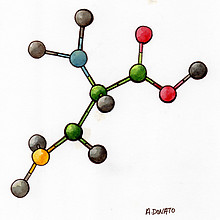Clarifying the Mechanism of Action of N-Acetylcysteine (NAC)
 N-acetylcysteine (NAC) is a drug available over-the-counter in health food stores that seems to be effective for a variety of disorders, including depression and many different habits and addictions. Preventing relapse of cocaine abuse is one of its uses. Researcher Kathryn Reissner at the Medical University of South Carolina found that NAC increases the expression of a glial glutamate transporter (GLT-1) that helps clear excessive glutamate in the nucleus accumbens, and that this mechanism is critical to preventing the reinstatement of cocaine self-administration in rodents.
N-acetylcysteine (NAC) is a drug available over-the-counter in health food stores that seems to be effective for a variety of disorders, including depression and many different habits and addictions. Preventing relapse of cocaine abuse is one of its uses. Researcher Kathryn Reissner at the Medical University of South Carolina found that NAC increases the expression of a glial glutamate transporter (GLT-1) that helps clear excessive glutamate in the nucleus accumbens, and that this mechanism is critical to preventing the reinstatement of cocaine self-administration in rodents.
As we have previously described in the BNN, NAC also decreases cued release of glutamate in the nucleus accumbens by potentiating the cystine-glutamate exchanger. This initially increases extrasynaptic glutamate, but subsequently downregulates glutamate release in the nucleus accumbens through actions at an inhibitory presynaptic metabotropic glutamate receptor.
However, the new data indicate that this action at the cystine-glutamate exchanger is not required for NAC’s effects on cocaine reinstatement, but the induction of GLT-1 is. Furthermore, another compound, propentofylline, which increases glutamate GLT-1, is also effective in suppressing cocaine reinstatement. Cocaine decreases a marker of glial activity, glial fibrillary acidic protein (GFAP), in the nucleus accumbens, suggesting that deficient glial functioning and uptake of glutamate could be another target of therapeutics in cocaine addiction.
Editor’s Note: There are also glial deficits in depressed patients, so it is conceivable that NAC’s effect on GLT-1 glutamate clearance is also involved in the antidepressant effects of NAC.

